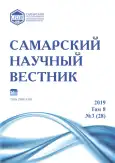Absolute chronology of ceramics of the Lugovskoy type
- Authors: Andreev K.M.1, Vybornov A.A.1, Kulkova M.A.2, Khramov D.Y.1
-
Affiliations:
- Samara State University of Social Sciences and Education
- Herzen State Pedagogical University of Russia
- Issue: Vol 8, No 3 (2019)
- Pages: 132-135
- Section: Historical Sciences and Archaeology
- URL: https://journals.rcsi.science/2309-4370/article/view/34364
- DOI: https://doi.org/10.17816/snv201983204
- ID: 34364
Cite item
Full Text
Abstract
The ceramics of the Lugovskoy type is represented by small straight-walled, weakly profiled or rounded canals with a flat or flat-concave bottom. The surface of the vessels is carefully smoothed, the external one is clogged. The fragments of ceramics have a visually dense molding material; the original plastic raw materials are silty clay, which sometimes contain an admixture of sand, shell or organic matter. The bulk of the vessels are ornamented only with horizontal bands of pits or pearls, sometimes along the neck of the vessels. The formation of the Lugovskoy type is associated with the interaction of the Elshanskaya and Lower Volga populations, while the Elshanskaya component was dominant. The existence of the Lugovskoy type dishes belongs to the end of the early Neolithic period of the forest-steppe Volga region and characterizes the second stage of the development of the Elshanskaya culture. The problem of the absolute chronology of the Lugovskoy ceramics hasn’t been studied yet. As a rule, the dating obtained for vessels of this type were considered in the context of the general chronology of the Elshanskaya culture and did not receive an appropriate interpretation in special works. To fill this gap is the main task of this paper. During the analysis of a representative series of radiocarbon determinations, it was established that the existence time of the dishes of the Lugovskoy type can be determined within the end of the first – second quarter of the 6th millennium BC. At the same time, with an increase in the radiocarbon date bank, the expansion of the chronological framework for the development of the final stage of the early Neolithic of the forest-steppe Volga region cannot be ruled out.
Full Text
##article.viewOnOriginalSite##About the authors
Konstantin Mikhailovich Andreev
Samara State University of Social Sciences and Education
Author for correspondence.
Email: konstantin_andreev_88@mail.ru
candidate of historical sciences, associate professor of Domestic History and Archeology Department
Russian Federation, SamaraAlexander Alekseevich Vybornov
Samara State University of Social Sciences and Education
Email: vibornov_kin@mail.ru
doctor of historical sciences, professor, head of Domestic History and Archeology Department
Russian Federation, SamaraMarianna Alekseevna Kulkova
Herzen State Pedagogical University of Russia
Email: kulkova@mail.ru
candidate of geological and mineralogical sciences, associate professor of Geology and Geoecology Department
Russian Federation, Saint PetersburgDmitriy Yurievich Khramov
Samara State University of Social Sciences and Education
Email: khramov.dimaa@mail.ru
master student of Domestic History and Archeology Department
Russian Federation, SamaraReferences
- Васильев И.Б., Выборнов А.А. Неолит Поволжья. Куйбышев: КГПИ, 1988. 112 с.
- Васильев И.Б., Выборнов А.А. Неолитические культуры лесостепного Поволжья и их взаимодействие с населением лесного Волго-Камья // Проблемы изучения раннего неолита лесной полосы Европейской части СССР. Ижевск: Удм. ИИЯЛИ УО АН СССР, 1988. С. 78–91.
- Выборнов А.А. Неолит Волго-Камья. Самара: СГПУ, 2008. 490 с.
- Васильева И.Н., Выборнов А.А. Новые подходы к изучению неолитизации в Среднем Поволжье // Самарский край в истории России. Вып. 4. Самара: Изд-во Самарского областного краеведческого музея, 2012. С. 61–68.
- Васильева И.Н., Выборнов А.А. Неолитический керамический комплекс Ильинской стоянки: датировка и технология // Археологические памятники Оренбуржья. Вып. 12. Оренбург: ООО ИПК «Университет», 2016. С. 5–20.
- Буров Г.М. Неолитические стоянки Ульяновского Поволжья // Энеолит Восточной Европы. Куйбышев: КГПИ, 1980. С. 93–103.
- Кузьмина О.В., Ластовский А.А. Стоянка Красной Городок // Древние культуры лесостепного Поволжья. Самара: СГПУ, 1995. С. 25–50.
- Выборнов А.А., Мамонов А.Е., Королев А.И., Овчинникова Н.В. Неолитическая керамика стоянки Лебяжинка IV в лесостепном Поволжье // Вестник СГПУ. Исторический факультет. Самара: СГПУ, 2007. С. 107–155.
- Мамонов А.Е. Ильинская стоянка и некоторые проблемы неолита лесостепного Заволжья // Проблемы изучения раннего неолита лесной полосы Европейской части СССР. Ижевск: Удм. ИИЯЛИ УО АН СССР, 1988. С. 92–105.
- Барынкин П.П., Козин Е.В. Некоторые результаты исследований II Большераковской стоянки // Древности Восточно-Европейской лесостепи. Самара: СГПУ, 1991. С. 94–119.
- Вискалин А.В. Елшанка XI – новая стоянка средневолжской неолитической культуры на Верхней Свияге // Исторические исследования. Вып. 5. Самара: Изд-во СГПУ, 2004. С. 144–154.
- Андреев К.М., Выборнов А.А. Ранний неолит лесостепного Поволжья (елшанская культура): монография. Самара: ООО «Порто-Принт», 2017. 272 с.
- Ставицкий В.В. К вопросу о взаимодействии неолитического населения степной и лесостепной зоны в Поволжье // Самарский научный вестник. 2014. № 4 (9). С. 117–121.
- Вискалин А.В. Проблема культурного единства и происхождения комплексов ранненеолитической керамики луговского типа на Средней Волге и в Прикамье // Проблемы изучения эпохи первобытности и раннего Средневековья лесной зоны Восточной Европы. Вып. 4. Иваново: Издатель Ольга Епишева, 2015. С. 33–38.
- Андреев К.М., Выборнов А.А. Ранний неолит лесостепного Поволжья (елшанская культура): монография. Самара: ООО «Порто-Принт», 2017. 272 с.
- Выборнов А.А., Андреев К.М., Кулькова М.А., Нестеров Е.М. Радиоуглеродные данные к хронологии неолита лесостепного Поволжья // Радиоуглеродная хронология эпохи неолита Восточной Европы VII–III тыс. до н.э. Смоленск: Свиток, 2016. С. 74–96.
- Выборнов А.А. Неолит степного-лесостепного Поволжья и Прикамья: автореф. дис. … д-ра ист. наук. Ижевск, 2009. 44 с.
Supplementary files







